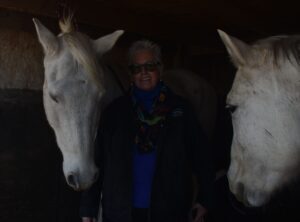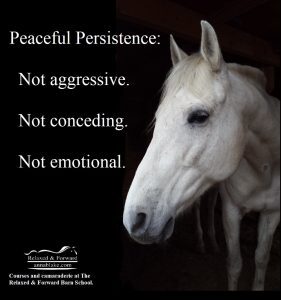Do You Have Coyote Eyes? How to Look Without Looking

Can you tell when someone’s looking at you? Or maybe a child in a waiting room, or it could be your mother. They are big at staring. It’s easy to feel your dog’s eyes, a language without words. What about a stare from someone who doesn’t look like you in a coffee shop? What about walking down an unfamiliar street at night while someone across the road walks parallel while looking at you? Of course, you notice. This last example is probably the closest to how horses feel when we scrutinize them for a calming signal. Can you imagine the glare white-hot glare experienced by animals, especially prey animals, when we stare at them? Wait, do you even notice you’re staring?
At a recent clinic, we moved as a group to a close-by farm where some participants kept their horses in a well-settled herd in a large turnout. The sight of a group of strangers standing and staring respectfully totally undid them. On one hand, we saw lots of calming signals, but if they do them because of us, we have intruded over the line of watching and into the realm of stalking prey. Owners didn’t recognize their horses. We were coyotes. Want another example of staring causing stress? Any vet visit.
My colleague and friend in Australia, Megan, asked if I would say something about the art of looking without looking. This comes up a lot when we talk with clients about calming signals. Earnest students stare with the intensity of a double-barreled lighthouse and sure enough, the horse looks away. A lot of horses close their eyes when our intensity is overwhelming. Others might graze frantically, stress eating. Or drop and roll for a reset when the incident is over. There are a few reasons a horse might use these calming signals, and there is much for us to learn. But do we want to be the cause?
The problem isn’t how limited our senses are compared to other mammals. It’s that we think we know everything. The language of horses is subtle, and we roll in loud and abrasive without intent to disrupt. Daydreaming rather than being aware of the environment. Our senses, never that sharp to begin with, get dull and rusty from lack of more than cursory use. It isn’t that we never inspect a wound, for example. It’s that we have enough self-awareness to adjust our volume to be easier on the horse the rest of the time.
The idea of looking without looking means to focus your attention by unfocusing your eyes. Alert in your senses, but quiet in your body.
I first learned this way of seeing while studying martial arts. The instructor asked us to look at a thing, but then soften our gaze and quietly notice what else we could see in our peripheral vision. The things we could see without moving our heads. It is not having a laser focus on a point, but a soft focus on a wider view. It’s a way of picking up movement in a crowd or having a wider view. The more you use it, the clearer it gets. In our case, it’s seeing the space the horse’s body inhabits instead of glaring into his eye. We become less aggressive in our bodies and less of a threat to our thousand-pound partners.
I’ve seen folks approaching a horse, doing strange things, trying to mimic them. Turning bodies at weird angles, pretending to do horse behaviors, yawn to make the horse yawn. Or sitting in a chair as if they are distracted. We are obvious; they read us like a comic book. We would do better to not try to fool animals whose senses are so much more acute than ours.
I want to listen, but not cue behaviors. Not pretending to be another species, I’d rather try to turn myself into a safe place. Think of it as a cloaking device that makes me slightly less visible. Softening my vision cools my energy. If I need to adjust the energy of my body, I’ll use my breath to inhale and let the energy in my solar plexus percolate or settle. I might move my feet, but my hands are the last resort, the choice of a predator. Let calmness start with your eyes.
Instead of mocking horses (sorry/not sorry) I will train myself to soften my vision. I will notice my breath and if I’m not breathing, I’ll make a new habit of rhythmic breathing. I’ll practice and give myself affirmations that I’m doing well. And while I’m doing that, I’ll let my vision go wide, I’ll make a new habit of softening my eyes, looking without looking, and practice that as well. I’ll have to train myself because I’m only human. I have limited senses compared to other mammals.
Something about this exercise should seem familiar. Yup, it’s the way horses see the world. They can’t see directly in front or behind themselves, but use strong peripheral vision in a sweeping arc from both flanks. We’re learning to see the world as a horse does, to use our senses rather than leaping to conclusions with that overbearing frontal cortex of ours. We quiet the noise and try to sense movement outside our stillness. It’s a Zen-ish concept. We look without looking.
Here’s how you can tell you’re doing it right:
We notice we can focus longer; more engaged in the environment, less distracted by chatter and bad advice.
We notice we’re standing farther away because we can see the stress we cause being too close.
We notice the sweetness in the air, the comfort of the Earth holding our weight, the quiet thrill of breathing.
We notice dogs come to us with a slow wag and lay at our feet.
We stop asking, cuing, nagging, and start listening. Our horses begin to relax.
We wait for the horse to communicate. It will take time because horses expect us to interrupt.
We wait some more, and they become responsive. Not really, but we notice it now.
We oil our gate hinges because the noise is suddenly offensive.
We can never sneak up on a horse, but sometimes they pretend we haven’t disturbed them.
We groom like it’s a slow dance because their calming signals say they like it that way.
We change anything else they ask us to. It’s not about us. (for Megan)
We notice the horse is calmer, more confident. We are ridiculously grateful. Amen.
We hear their breathing in rhythm with ours. Then we get over ourselves, but keep breathing.
We stop being so boy-howdy holy and let out a fart. The horses blow, and we relax more.
We notice that our horses willingly volunteer for any task.
We stop being anything we used to think we wanted to be. We are almost invisible.
We don’t worry about whether the horse’s eye is soft because ours is. We’ve changed teams.

…
If you appreciate what I do, please Subscribe to this blog or join us at The Barn School.

Anna Blake, Relaxed & Forward
Want more? Become a “Barnie.” Subscribe to our online training group with affirmative demonstration videos, audio blogs, daily quotes, free participation in “group lessons”, and live chats with Anna. Become part of the most supportive group of like-minded horsepeople anywhere.
Anna teaches ongoing courses like Calming Signals and Affirmative Training at The Barn School, along with virtual clinics and our infamous Happy Hour. Everyone’s welcome.
Visit annablake.com to find archived blogs, purchase signed books, schedule a live consultation, subscribe for email delivery of this blog, or ask a question about the art and science of working with horses.
Affirmative training is the fine art of saying yes.
The post Do You Have Coyote Eyes? How to Look Without Looking appeared first on Anna Blake.



